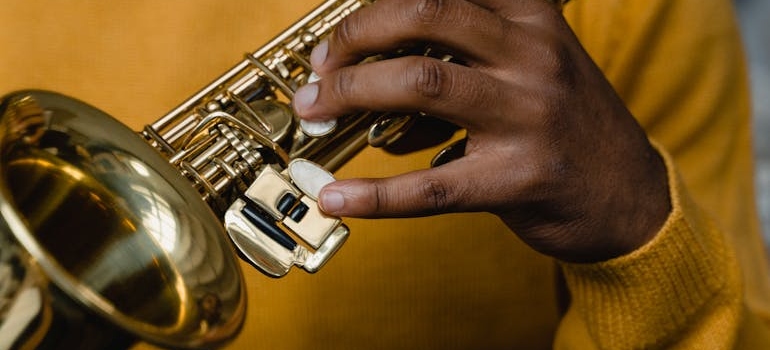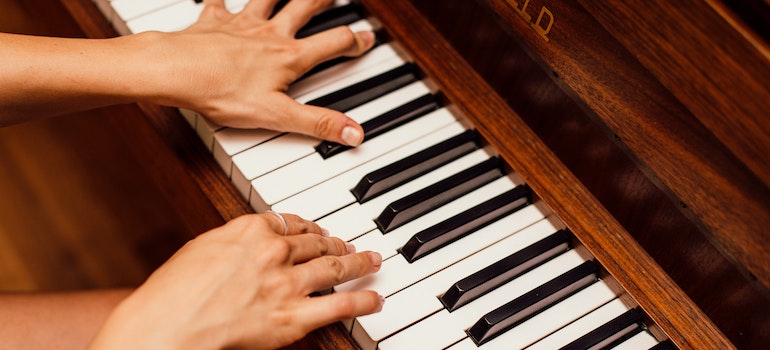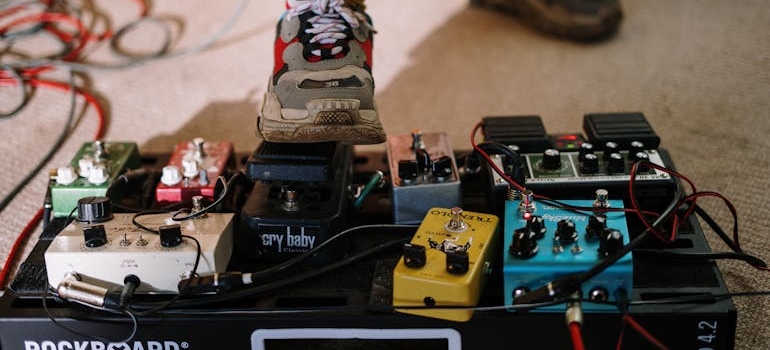Packing Musical Instruments for a Long-distance Move in WA
Washington State is a haven for musicians, from the vibrant streets of Seattle to the picturesque towns scattered across the region. The diverse climate of Washington, characterized by its notorious rainy seasons and fluctuating humidity levels, presents unique challenges for any move. Hence, properly packing musical instruments for a long-distance move in WA is essential for protecting your instruments from potential damage. Our guide offers expert advice tailored to the specific weather conditions and logistical hurdles you may encounter. With the right approach that the best movers and packers in Seattle suggest, your instruments will arrive at your new home intact and ready to continue making beautiful music.
General Considerations for Packing Musical Instruments
For professional musicians relocating to a new city, students heading off to college, or hobbyists undertaking a new adventure, safeguarding cherished musical instruments during transit is paramount. It also requires careful planning and attention to detail. As a musician, you understand the value and sensitivity of your instruments. So, ensuring they arrive safely at your new home involves several critical steps.
Importance of Temperature and Humidity Control
Musical instruments are highly sensitive to temperature and humidity changes, which can be extreme in Washington State. Protect your instruments by keeping them in a climate-controlled environment as much as possible during the move. Consider using silica gel packs to control moisture levels inside cases and boxes. This extra step helps prevent warping, cracking, and other damage caused by environmental fluctuations.

Basic Packing Materials Needed
Start by gathering essential packing materials. Use bubble wrap to cushion delicate parts and packing peanuts to fill empty spaces and prevent movement. Choose sturdy boxes that can withstand the weight and pressure of stacking during transit. If the original case for your instrument isn’t available, ensure that any alternative packing method offers similar protection. Custom-fit foam inserts can provide additional security and support.
Tips for Labeling Boxes as “Fragile” and Handling Instructions
Clearly label each box containing musical instruments with “Fragile” to alert your chosen long-distance movers in Seattle to handle these items with care. Include specific handling instructions, such as “This Side Up” or “Do Not Stack.” These labels help ensure that your instruments receive the gentle treatment they require. Additionally, consider placing your contact information on each box in case any issues arise during the move.
String Instruments
String instruments require careful handling and packing due to their delicate nature. The weather in Washington State, with its high humidity and frequent rain, necessitates additional precautions to prevent damage.
Guitars
For guitars, begin by loosening the strings to reduce tension on the neck. Ideally, use the original hard case, which offers the best protection. Wrap the guitar in bubble wrap, ensuring all parts are covered, and place it in the case. Fill any empty spaces with packing peanuts or soft cloth to prevent movement. If the original case is unavailable, use a padded gig bag to pack a guitar and place it wrapped in a sturdy, well-padded box.
Violins, Violas, Cellos, and Double Basses
Violins, violas, cellos, and double basses need extra care. Loosen the strings slightly and secure bows separately in a protective tube or wrapped in bubble wrap. Use hard cases for each instrument, filling any gaps with soft padding. Consider placing humidity control packs inside the case to maintain stable conditions. If a hard case is not available, wrap the instrument thoroughly in bubble wrap and secure it in a sturdy box with ample padding.
Wind Instruments
Wind instruments are intricate and require careful packing to prevent damage to their delicate components. The climate in the state that every moving company in Washington knows well can pose additional risks. Proper disassembly and wrapping are crucial to protect these instruments during a long-distance move.
Flutes, Clarinets, and Oboes
As you’re packing musical instruments for a long-distance move in WA, you should disassemble your instrument to its individual parts. For flutes, separate the head joint, body, and foot joint. For clarinets and oboes, disassemble the upper and lower joints, bell, and barrel. Wrap each part separately in bubble wrap, ensuring all surfaces are covered. Use tape to secure the bubble wrap, but avoid taping directly to the instrument to prevent residue.
Place the wrapped parts into a padded case. If the original case is unavailable, use a sturdy box lined with soft padding. Arrange the wrapped parts carefully, filling any empty spaces with packing peanuts or soft cloth to prevent movement. Including desiccant packets inside the case or box helps manage moisture levels, protecting the instrument from Washington’s humid climate.
Saxophones
Disassemble the saxophone by removing the neck and mouthpiece. Wrap the body, neck, and mouthpiece separately in bubble wrap, ensuring that the keys and other delicate parts are well-protected with extra layers of padding.

Use a fitted hard case or a sturdy, well-padded box, ensuring the wrapped parts do not touch each other to avoid scratches or dents. Fill any empty spaces with packing material to prevent shifting during transit. Label the box with “Fragile” and specific handling instructions, such as “This Side Up.”
Brass Instruments (Trumpets, Trombones, Tubas)
You should disassemble the instrument as much as possible. For trumpets, remove the mouthpiece and any detachable tuning slides. For trombones, separate the slide and bell sections. Tubas may have detachable valves and slides. Wrap each part individually in bubble wrap, paying extra attention to valves and slides, which are particularly delicate.
Place the wrapped parts into a sturdy case with interior padding, or use a well-padded box if the case is unavailable. Arrange the wrapped parts carefully, ensuring they do not touch each other directly. Fill any empty spaces with packing material, such as packing peanuts, foam inserts, or soft cloth, to prevent movement. Include desiccant packets to manage moisture levels inside the case or box. Label the box with “Fragile” and clear handling instructions.
Percussion Instruments
Percussion instruments vary widely in size and shape, requiring specific packing strategies to ensure their safe transport. Given Washington State’s humid and often rainy climate, knowing how to pack drums for moving and extra precautions are necessary to prevent damage.
Drums
For drums, start by removing the drum heads and wrapping them separately in bubble wrap. This prevents any pressure from being applied to the drum heads during the move, which can cause damage. Wrap the drum shells in bubble wrap as well, paying special attention to the edges and hardware. Use hard cases or padded drum bags to provide optimal protection. Fill any empty spaces with packing peanuts or soft cloth to prevent movement and potential damage.
Cymbals
Use cymbal bags with dividers to pack cymbals. Before placing the cymbals in the bag, wrap each one in bubble wrap to provide additional cushioning. Secure the cymbal bag within a sturdy box filled with packing peanuts or soft cloth to prevent movement. This double-layer protection helps shield the cymbals from impacts and environmental conditions.
Other Percussion Instruments (Tambourines, Maracas, etc.)
Smaller percussion instruments, such as tambourines and maracas, require individual wrapping in bubble wrap. Place each wrapped instrument in small, sturdy boxes with ample padding to protect them from impacts. Clearly label these boxes and secure them to ensure they are handled with care during the move. For larger and more delicate percussion instruments, use additional padding and sturdy boxes to prevent damage.
Keyboard Instruments
Keyboard instruments, whether acoustic or electronic, require special attention during packing musical instruments for a long-distance move in WA due to their size and complexity. Moving these instruments in Washington State involves careful planning to mitigate risks from humidity and physical damage.
Pianos
Wondering how to pack a piano for moving? Moving a piano necessitates professional assistance from Seattle piano movers due to its size, weight, and delicate components. Wrap the piano in moving blankets to protect the surface from scratches and impacts. Secure the blankets with plastic wrap to keep them in place during transit.
Make sure the piano is properly secured within the moving truck to prevent shifting. Climate control is essential, as pianos are highly sensitive to temperature and humidity changes. Inform the movers about the piano’s specific conditions to ensure it is handled with the utmost care.

Electronic Keyboards
For electronic keyboards, start by removing and securing any detachable parts, such as stands, pedals, and music rests. Wrap the keyboard in bubble wrap, making sure to cover all sides and corners. If you have the original packaging, use it, as it provides the best fit and protection.
If not, place the wrapped keyboard in a sturdy box with ample padding to prevent movement. Pack cables and accessories separately in labeled bags to keep everything organized and avoid tangling. Desiccant packets can be added to the box to manage moisture levels.
Electronic Equipment
Electronic equipment requires careful packing to avoid damage during a move. The damp climate of Washington State can pose additional risks, making it crucial to take extra precautions to protect these valuable items:
- Amplifiers
- Mixers
- Audio interfaces
- Cables
- Power supplies
- Microphones
- Pedals
- Recording equipment
In essence, proper wrapping, the use of sturdy boxes, and careful packing of accessories will help protect your gear from the physical and environmental challenges of a long-distance move in Washington State. Here are the details.
Wrapping Individual Components
Start by wrapping individual components, such as amplifiers and mixers, in bubble wrap. This provides a protective layer that cushions against shocks and prevents scratches. Focus on vulnerable parts like corners and edges to ensure comprehensive protection. Ensure that all surfaces are well-covered and that the bubble wrap is secured with tape, but avoid taping directly to the equipment to prevent residue.
Using Original Boxes or Sturdy Alternatives
Whenever possible, use the original boxes for packing these items, as they are designed to provide the best fit and protection. If the original boxes are not available, choose sturdy shipping crates in Seattle with ample padding. These boxes should be strong enough to support the weight of the equipment without crushing. Fill any empty spaces within the boxes with packing peanuts or foam inserts to absorb impacts and keep the equipment secure during transit.
Labeling and Securing Cables and Accessories Separately
Cables, power supplies, and other accessories should be prepared separately before packing musical instruments for a long-distance move in WA. Coil each cable neatly and secure it with a twist tie or cable strap. Place cables in labeled zip-lock bags or pouches, and pack these in a box with other accessories. Use bubble wrap or packing peanuts to fill any empty spaces, preventing movement and potential damage. Label each box clearly with its contents and handling instructions to ensure they are managed with care during the move.

Specific Challenges in Washington State
Moving musical instruments in Washington State presents unique challenges due to its climate and geography. Frequent rain and high humidity levels can damage instruments, so use waterproof covers and silica gel packs to protect against moisture. Temperature fluctuations can cause condensation, so let instruments acclimate gradually to new environments. The state’s diverse terrain, including mountains and coastal areas, requires careful navigation.
Hence, ensure your moving truck can handle steep inclines and potential flooding. If delays occur, use climate-controlled storage facilities to maintain consistent temperature and humidity levels. Professional movers experienced with local conditions can provide valuable assistance, ensuring your instruments arrive safely and in optimal condition.
Hit the Right Note with Your Move
The same is true for all specialty items; packing musical instruments for a long-distance move in Washington State requires careful attention to detail. Addressing humidity, temperature fluctuations, and the state’s diverse terrain is crucial to protecting your valuable gear. Utilize expert packing techniques and seek professional HB move management assistance to ensure your instruments arrive safely. With the right approach, your instruments will be in perfect condition and ready for your next performance!
Why Choose Us
History
Hansen Bros. Moving & Storage is locally owned and operated by the same family for four generations, since 1890. We have a well-established reputation for service quality and reliability with a high percentage of repeat household and commercial clients.
Professionalism
We’re a certified ProMover by the American Moving and Storage Association with A+ rating with the Better Business Bureau, voted “Best in Western Washington” in 2009 and from 2011 to 2016 by KING5. Our company is fully licensed and insured and member of WMC and AMSA.
Value
Hansen Bros. Moving & Storage provide free, no-obligation in-home estimate and competitive rates, including low minimum rates for shipments moving under 300 miles. We’ve set a refund policy for unused packing materials and three Puget Sound locations to help clients save on travel fee costs.



